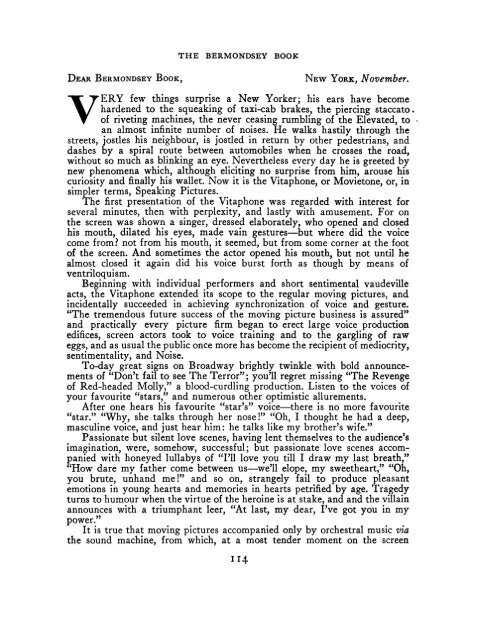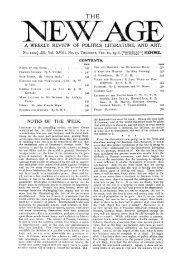Vol. VI No. 1 - Modernist Magazines Project
Vol. VI No. 1 - Modernist Magazines Project
Vol. VI No. 1 - Modernist Magazines Project
Create successful ePaper yourself
Turn your PDF publications into a flip-book with our unique Google optimized e-Paper software.
THE BERMONDSEY BOOK<br />
DEAR BERMONDSEY BOOK,<br />
NEW YORK, <strong>No</strong>vember.<br />
VERY few things surprise a New Yorker; his ears have become<br />
hardened to the squeaking of taxi-cab brakes, the piercing staccato*<br />
of riveting machines, the never ceasing rumbling of the Elevated, to<br />
an almost infinite number of noises. He walks hastily through the<br />
streets, jostles his neighbour, is jostled in return by other pedestrians, and<br />
dashes by a spiral route between automobiles when he crosses the road,<br />
without so much as blinking an eye. Nevertheless every day he is greeted by<br />
new phenomena which, although eliciting no surprise from him, arouse his<br />
curiosity and finally his wallet. <strong>No</strong>w it is the Vitaphone, or Movietone, or, in<br />
simpler terms, Speaking Pictures.<br />
The first presentation of the Vitaphone was regarded with interest for<br />
several minutes, then with perplexity, and lastly with amusement. For on<br />
the screen was shown a singer, dressed elaborately, who opened and closed<br />
his mouth, dilated his eyes, made vain gestures—but where did the voice<br />
come from? not from his mouth, it seemed, but from some corner at the foot<br />
of the screen. And sometimes the actor opened his mouth, but not until he<br />
almost closed it again did his voice burst forth as though by means of<br />
ventriloquism.<br />
Beginning with individual performers and short sentimental vaudeville<br />
acts, the Vitaphone extended its scope to the regular moving pictures, and<br />
incidentally succeeded in achieving synchronization of voice and gesture.<br />
"The tremendous future success of the moving picture business is assured"<br />
and practically every picture firm began to erect large voice production<br />
edifices, screen actors took to voice training and to the gargling of raw<br />
eggs, and as usual the public once more has become the recipient of mediocrity,<br />
sentimentality, and <strong>No</strong>ise,<br />
To-day great signs on Broadway brightly twinkle with bold announcements<br />
of "Don't fail to see The Terror"; you'll regret missing "The Revenge<br />
of Red-headed Molly," a blood-curdling production. Listen to the voices of<br />
your favourite "stars," and numerous other optimistic allurements.<br />
After one hears his favourite "star's" voice—there is no more favourite<br />
"star." "Why, she talks through her nose!" "Oh, I thought he had a deep,<br />
masculine voice, and just hear him: he talks like my brother's wife."<br />
Passionate but silent love scenes, having lent themselves to the audience's<br />
imagination, were, somehow, successful; but passionate love scenes accompanied<br />
with honeyed lullabys of "I'll love you till I draw my last breath,"<br />
"How dare my father come between us—we'll elope, my sweetheart," "Oh,<br />
you brute, unhand me!" and so on, strangely fail to produce pleasant<br />
emotions in young hearts and memories in hearts petrified by age. Tragedy<br />
turns to humour when the virtue of the heroine is at stake, and and the villain<br />
announces with a triumphant leer, "At last, my dear, I've got you in my<br />
power."<br />
It is true that moving pictures accompanied only by orchestral music via<br />
the sound machine, from which, at a most tender moment on the screen<br />
114












